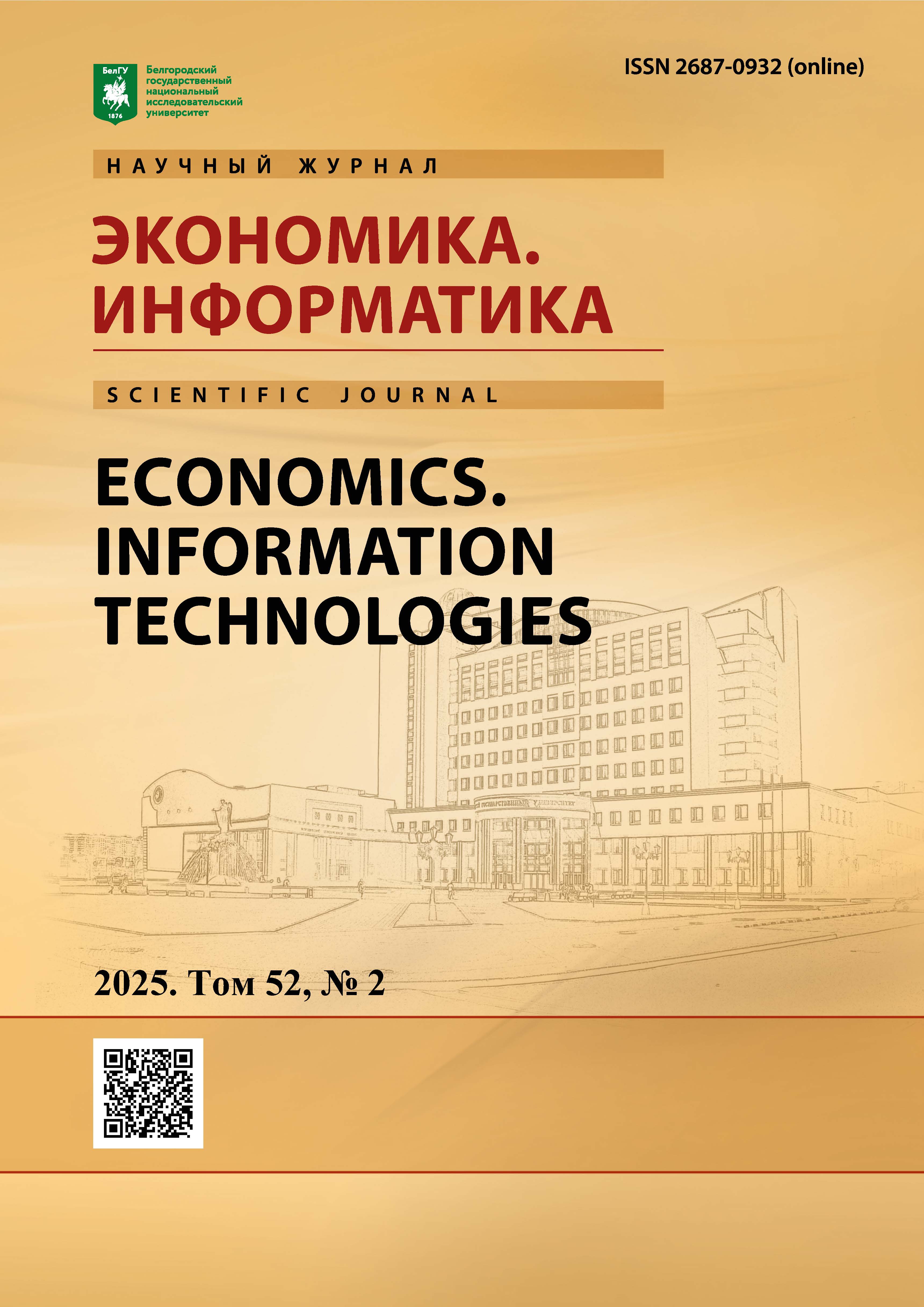Переосмысление функций экономического пространства в условиях усложнения пространственной организации и цифровой трансформации экономики
DOI:
https://doi.org/10.52575/2687-0932-2025-52-2-268-278Ключевые слова:
территориальное развитие, цифровизация, пространственная связанность, интеграция регионов, институциональные измененияАннотация
В статье предлагается систематизация и переосмысление функций экономического пространства в условиях цифровизации, институциональных трансформаций и усложнения логики пространственной организации экономики. На основе обобщения теоретических подходов и анализа современных эмпирических кейсов обосновывается необходимость расширения классической типологии функций. Рассматриваются институциональная, координирующая, связывающая, интеграционная и производственная функции, анализируется их эволюция и взаимосвязи. Подчёркивается их роль в формировании более гибкой и адаптивной модели пространственного развития.
Благодарности: исследование выполнено в рамках государственного задания НИУ «БелГУ» FZWG-2023-0014, тема проекта «Пространственно-сетевое взаимодействие российских регионов в контексте новых вызовов технологического развития».
Скачивания
Библиографические ссылки
Список источников
Arcep, 2025. Le plan France Très Haut Débit (PFTHD). URL: arcep.fr/mes-demarches-et-services/collectivites/fiches-pratiques/le-plan-france-tres-haut-debit-pfthd.html (дата обращения: 25.04.2025).
European Territorial Cooperation – INTERREG. URL: social-economy-gateway.ec.europa.eu/eu-funding-programmes/european-territorial-cooperation-interreg_en (дата обращения: 23.04.2025).
OECD, 2020. OECD Digital Economy Outlook 2020. Paris: OECD Publishing. DOI: 10.1787/bb167041-en.
Список литературы
Бияков О.А. 2004. Экономический процесс: сущность, анализ и синтез понятия. Вестник Кузбасского государственного технического университета, 1: 82–88.
Бияков О.А. 2004. Экономическое пространство: сущность, функции, свойства. Вестник Кузбасского государственного технического университета, 2: 101–108.
Минакир П.А., Демьяненко А.Н. 2010. Пространственная экономика: эволюция подходов и методология. Пространственная экономика, 2: 6–32.
Мирзабалаев Р.В. 2023. Связанность экономического пространства как фактор территориального развития. РЭиУ, 4 (76).
Allen J. 2011. Topological twists: Power’s shifting geographies. Dialogues in Human Geography, 1(3): 283-298. DOI: 10.1177/2043820611421546.
Bathelt H., Glückler J. 2014. Institutional change in economic geography. Progress in Human Geography, 38(3). DOI: 10.1177/0309132513507823.
Coyle D. 2016. The Political Economy of National Statistics. Economics Discussion Paper Series No. EDP-1603, The University of Manchester.
Giannakis E., Papadas С. 2021. Spatial Connectivity and Regional Economic Resilience in Turbulent Times. Sustainability, 13(20). DOI: 10.3390/su132011289.
Harrison D., Munksgaard K., Prenkert F. 2023. Coordinating Activity Interdependencies in the Contemporary Economy: The Principle of Distributed Control. British Journal Management, 34: 1488–1509. DOI: 10.1111/1467-8551.12650.
Marin V., Molinero C., and Arcaute E. 2024. The scalar mismatch of regional governance: a comparative analysis of hierarchical structures. Environment and Planning B, 51(9): 2126–2145. DOI: 10.1177/23998083241234405.
Porter M. 1998. Clusters and the New Economics of Competition. Harvard Business Review, 76: 77-90.
Richardson G. 1972. The Organisation of Industry. The Economic Journal, 82(327): 883–896. DOI: 10.2307/2230256.
Sutton J., Godwin A. 2022. Regional economic resilience: towards a system approach. Regional Studies, Regional Science, 9(1): 497–512. DOI: 10.1080/21681376.2022.2092418.
Vuong Q., Ho M., Nguyen H, Nguyen M. 2019. The trilemma of sustainable industrial growth: evidence from a piloting OECD’s Green city. Palgrave Communications, 5(156). DOI: 10.1057/s41599-019-0369-8.
Wang M., Zhang M., Chen H., Yu D. 2023. How Does Digital Economy Promote the Geographical Agglomeration of Manufacturing Industry. Sustainability, 15(2), 1727. DOI: 10.3390/su15021727.
Wright A.L., Irving G., Zafar A., Reay T. 2023. The Role of Space and Place in Organizational and Institutional Change: A Systematic Review of the Literature. Journal of Management Studies, 60: 991–1026. DOI: 10.1111/joms.12868.
Zhao X., Lan F, Zhang L. 2025. The impact of digital village construction on poverty vulnerability among rural households. Sci Rep 15, 9967. DOI: 10.1038/s41598-025-91928-7.
References
Biyakоv O.A. 2004. The Economic Process: Essence, Analysis and Synthesis of the Concept. Bulletin of the Kuzbass State Technical University, 1: 82–88.
Biyakоv O.A. 2004. Economic Space: Essence, Functions, and Properties. Bulletin of the Kuzbass State Technical University, 2: 101–108.
Minakir P.A., Demyanenko A.N. 2010. Spatial Economy: Evolution of Approaches and Methodology. Spatial Economics, 2: 6–32.
Mirzabalayev R.V. 2023. Connectivity of Economic Space as a Factor of Territorial Development. Russian Journal of Regional Economics and Management (RZhREiU), 4(76).
Allen J. 2011. Topological twists: Power’s shifting geographies. Dialogues in Human Geography, 1(3): 283–298. DOI: 10.1177/2043820611421546.
Bathelt H., Glückler J. 2014. Institutional change in economic geography. Progress in Human Geography, 38(3). DOI: 10.1177/0309132513507823.
Coyle D. 2016. The Political Economy of National Statistics. Economics Discussion Paper Series No. EDP-1603, The University of Manchester.
Giannakis E., Papadas С. 2021. Spatial Connectivity and Regional Economic Resilience in Turbulent Times. Sustainability, 13(20). DOI: 10.3390/su132011289.
Harrison D., Munksgaard K., Prenkert F. 2023. Coordinating Activity Interdependencies in the Contemporary Economy: The Principle of Distributed Control. British Journal Management, 34: 1488–1509. DOI: 10.1111/1467-8551.12650.
Marin V., Molinero C., and Arcaute E. 2024. The scalar mismatch of regional governance: a comparative analysis of hierarchical structures. Environment and Planning B, 51(9): 2126–2145. DOI: 10.1177/23998083241234405.
Porter M. 1998. Clusters and the New Economics of Competition. Harvard Business Review, 76: 77–90.
Richardson G. 1972. The Organisation of Industry. The Economic Journal, 82(327): 883–896. DOI: 10.2307/2230256.
Sutton J., Godwin A. 2022. Regional economic resilience: towards a system approach. Regional Studies, Regional Science, 9(1): 497–512. DOI: 10.1080/21681376.2022.2092418.
Vuong Q., Ho M., Nguyen H, Nguyen M. 2019. The trilemma of sustainable industrial growth: evidence from a piloting OECD’s Green city. Palgrave Communications, 5(156). DOI: 10.1057/s41599-019-0369-8.
Wang M., Zhang M., Chen H., Yu D. 2023. How Does Digital Economy Promote the Geographical Agglomeration of Manufacturing Industry. Sustainability, 15(2), 1727. DOI: 10.3390/su15021727.
Wright A.L., Irving G., Zafar A., Reay T. 2023. The Role of Space and Place in Organizational and Institutional Change: A Systematic Review of the Literature. Journal of Management Studies, 60: 991-1026. DOI: 10.1111/joms.12868.
Zhao X., Lan F, Zhang L. 2025. The impact of digital village construction on poverty vulnerability among rural households. Sci Rep 15, 9967. DOI: 10.1038/s41598-025-91928-7.
Просмотров аннотации: 245
Поделиться
Опубликован
Как цитировать
Выпуск
Раздел
Copyright (c) 2025 Экономика. Информатика

Это произведение доступно по лицензии Creative Commons «Attribution» («Атрибуция») 4.0 Всемирная.


